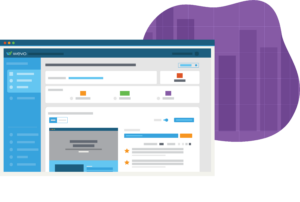Your website or landing page conversion rate starts to deteriorate, perhaps suddenly, perhaps gradually, and you’re not tracking to meet your conversion goals. Is this a canary or a canard? It’s hard to tell because conversion is just a surface measurement of so many underlying complicated processes. To determine why your conversion is declining, you need to truly understand the root cause(s). Unfortunately, that is nearly impossible with traditional A/B testing tools.
I’m in charge of analytics at WEVO, where we see a whole host of reasons for a sudden decline in conversion for our clients that necessitates action. Sometimes, it’s something page-based, e.g. the site has started to look outdated or is missing functionality the client desires. Often, an external event has led to the decline, such as a new offering by a competitor or a news event that has affected a client’s reputation. Or perhaps digital ads have changed the nature of the traffic sent to the site, so that the visitors are no longer the target audience. Clients often come to us hoping to diagnose the fundamental problem.
The canary in the goal mine is, of course, a familiar metaphor. On a tour of a defunct coal mine this past weekend, I learned more about this metaphor. The guide explained how the miners would bring the birds into the shafts where they were digging. Their small lungs were early detectors of toxic gases. The miners used to say, “While the birds were chirping, we are working.” When the birds stopped singing, they would go up to the surface.
The birds alerted the miners to carbon monoxide. But they were obviously a coarse measurement device. Sometimes, in the dark of the mine, they just fell asleep. Methane, a combustible (and therefore, explosive) airborne poison, was not detected by these little animals. And of course, they did nothing to identify the source of the toxins. For a while, the canaries were the best that the miners had available, and so they used them. But once better alarm systems were developed, they quickly upgraded.
The Conversion Complication
We tend to talk about conversion as a constant, e.g. “This page converts at 10%.” However, in reality, no single statistic defines conversion. It goes up and down by time of day, day of the week, month, and sometimes, even the weather. Depending on the industry, the periodicity of the conversion curves vary, but they are always there. In most industries, seasonal downturns are normal and fully-expected. For example, in higher education, there are months where people tend to think of going back to school, regardless of whether the school has a rolling semester. A decline could just be part of the normal variation. Or it could be a sign that big changes are needed, quickly.
The Canary
To get some directional data about the cause of the conversion slippage, you can use the marketing tools equivalent of a canary. The details will be obscured, but it may be enough to help you tell whether there is a fundamental problem with a page, and whether it is representative of a larger problem.
- Do another A/B test: The page that won a few months ago might not win today. What someone wants to see in October might be very different than what they want to see in February.
- Shifting audience: Customers often immediately dismiss a page if they don’t associate with the hero image. Take a look at your Google analytics and your enrollments. Has your audience been changing? Audiences are very sensitive to “it’s not for me.”
- Check the competition: What are your competitors up to? Were there any major changes to their sites or their offerings?
- Past due dates: Are there any start dates, imagery, or other items that might make customers believe that it’s “too late”?
- Statistical tests: Look at a comparable period, perhaps the previous month or the same month last year. Is the distribution of daily conversions statistically different from the period you are measuring?
The Digital Carbon Monoxide Detector
The canary only gets you so far. You want to detect the problem earlier, know how bad it is exactly, and whether it’s getting worse. None of this is going to come from tools that only measure conversion. You need something more sophisticated, which can detect underlying causes. Using a mix of machine learning and crowd-sourcing technology, WEVO performs more tests to better hone in on the problem, and give insight to the root causes.
This manifests itself in terms of five drivers. For example,
- Appeal: If a competitor has sweetened their offer, the “canary” might be decreasing conversion on one of your goals.
- Clarity: As buyers become more educated about their purchases, they expect more details about the offerings. While your offer may be clearly stated, missing details.
- Credibility: Marketers, who are intimately familiar with their brands, tend to think their target audience knows them better than they actually do. We often find that a little more about the company goes a long way.
- Experience: Sometimes, this is very simple, e.g. a button is broken or the page renders poorly in a browser/device that is gaining in popularity. Sometimes, this is endemic of a more fundamental problem, like audiences becoming more comfortable on converting from mobile devices.
- Relevance: Perhaps the wrong audience is coming to your page. Without a tool like WEVO, it’s very difficult to know whether the ads are sending the wrong people to the page, or whether the page itself is losing them. Obtaining the relevance score from your target audience can help untangle these factors.
The next step is to listen to the voices of your audience. WEVO will give you the reason people aren’t converting, rather than suffering in ignorance. It can even tell you what your target audience thinks of you.
And if conversion hasn’t been dropping? Well, the canary might be awake, but that doesn’t mean a problem isn’t building up. You can get ahead of the curve with a bit of foresight. “If the birds are chirping, you can keep working.”


